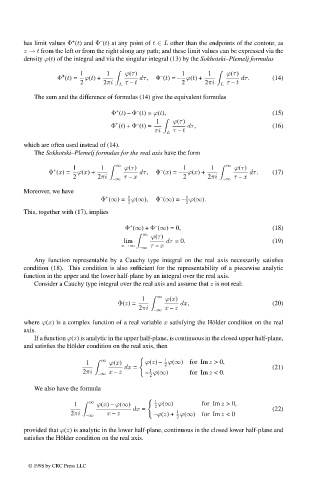Page 620 - Handbook Of Integral Equations
P. 620
–
+
has limit values Φ (t) and Φ (t) at any point of t ∈ L other than the endpoints of the contour, as
z → t from the left or from the right along any path; and these limit values can be expressed via the
density ϕ(t) of the integral and via the singular integral (13) by the Sokhotski–Plemelj formulas
1 1 ϕ(τ) – 1 1 ϕ(τ)
+
Φ (t)= ϕ(t)+ dτ, Φ (t)= – ϕ(t)+ dτ. (14)
2 2πi L τ – t 2 2πi L τ – t
The sum and the difference of formulas (14) give the equivalent formulas
+
–
Φ (t) – Φ (t)= ϕ(t), (15)
1 ϕ(τ)
–
+
Φ (t)+ Φ (t)= dτ, (16)
πi τ – t
L
which are often used instead of (14).
The Sokhotski–Plemelj formulas for the real axis have the form
1 1 ∞ ϕ(τ) – 1 1 ∞ ϕ(τ)
+
Φ (x)= ϕ(x)+ dτ, Φ (x)= – ϕ(x)+ dτ. (17)
2 2πi τ – x 2 2πi τ – x
–∞ –∞
Moreover, we have
1
+
1
–
Φ (∞)= ϕ(∞), Φ (∞)= – ϕ(∞).
2 2
This, together with (17), implies
+
–
Φ (∞)+ Φ (∞) = 0, (18)
∞
ϕ(τ)
lim dτ = 0. (19)
x→∞ τ – x
–∞
Any function representable by a Cauchy type integral on the real axis necessarily satisfies
condition (18). This condition is also sufficient for the representability of a piecewise analytic
function in the upper and the lower half-plane by an integral over the real axis.
Consider a Cauchy type integral over the real axis and assume that z is not real:
1 ∞ ϕ(x)
Φ(z)= dx, (20)
2πi x – z
–∞
where ϕ(x) is a complex function of a real variable x satisfying the H¨ older condition on the real
axis.
If a function ϕ(z) is analytic in the upper half-plane, is continuous in the closed upper half-plane,
and satisfies the H¨ older condition on the real axis, then
1
1 ∞ ϕ(x) ϕ(z) – ϕ(∞) for Im z >0,
2
dx = (21)
1
2πi x – z – ϕ(∞) for Im z <0.
–∞
2
We also have the formula
1
1 ∞ ϕ(x) – ϕ(∞) 2 ϕ(∞) for Im z >0,
dx = (22)
1
2πi x – z –ϕ(z)+ ϕ(∞) for Im z <0
–∞
2
provided that ϕ(z) is analytic in the lower half-plane, continuous in the closed lower half-plane and
satisfies the H¨ older condition on the real axis.
© 1998 by CRC Press LLC
© 1998 by CRC Press LLC
Page 603

